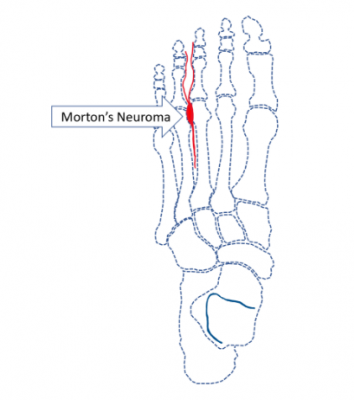Pain causing Plantar Fasciitis & Morton’s Neuroma
Why does my foot hurt?
A painful foot can be debilitating and prevent people from participating in activities as simple as standing or walking. This can be caused by trauma, overuse, or conditions causing inflammation involving any of the bones, ligaments or tendons in foot. Arthritis is the most common cause of pain in the foot however inflammation in the nerves and fascia can be just as debilitating.
What are the common non-arthritis causes of foot pain?
- Plantar Fasciitis
- Morton’s Neuroma
Plantar Fasciitis
What is Plantar Fasciitis?
Plantar Fasciitis is an inflammation of the thick band of connective tissue that runs along the sole of your foot. It normally helps support the shape of your foot when standing and is the most common cause of heel pain.
This condition can be extremely painful especially with the first few steps in the morning, and may feel like you’re walking on a golf ball.

Who gets Plantar Fasciitis and what causes it?
Plantar Fasciitis affects people of all ages however is more common in individuals between 40-60 years. Males and females are both as likely to get the condition and can occur in both feet simultaneously.
You are more likely to develop plantar fasciitis if you are overweight, have been wearing inappropriate shoe wear, lack flexibility in your calf muscles or participate in activities that require a lot of standing or walking on hard surfaces.
The cause of Plantar Fasciitis is often unknown. Overuse and repetitive microtrauma due to excessive pressure over the fascia cause it to tear and degenerate resulting in heel pain.
Book an Appointment Today!

Morton's Neuroma
What is a Morton’s Neuroma?
A Morton’s neuroma is a benign thickening of the tissue around a nerve leading to the toes. This usually occurs between the third and fourth toes and feels like a pebble in the shoe with an associated numbness and pain in the ball of the foot or toes.
Who gets a Morton’s Neuroma and what causes it?
Morton’s neuromas are more common in middle ages females and usually occur in one foot. The cause is usually due to excess pressure on the nerve due to the narrowing of the space between the toes resulting in thickening and scar tissue formation.
What are the symptoms of Morton’s Neuroma?
- Burning pain at the ball of the foot and / or toes.
- Numbness between the toes.
- Feels like you are “walking on a pebble”.
- Increased pain with tight shoe-wear and prolonged weight bearing.
- Pain relieved by rest, removal of shoe and MASSAGING of the forefoot.
How do you a diagnose Morton’s Neuroma?
Dr. Chow will take a thorough medical history and physical examination to delineate the nature of the pain, evaluate the degree of functional impairment and consider any other possible causes of pain in the foot.
Morton’s neuroma is often a clinical diagnosis however imaging is often required to rule out other causes of pain and confirm the neuroma. Xray, MRI and Ultrasound may be ordered by Dr. Chow depending on clinical examination.
What is the likely course for a Morton’s Neuroma if not surgically managed?
20% of patients will have a resolution of symptoms with non-operative management. It is difficult to recognize the patients that will be successful with non-operative measures and all attempts at conservative treatment should be initially trialed.

Plantar Fasciitis & Morton’s Neuroma Treatments
View treatments for Plantar Fasciitis & Morton’s Neuroma that our Doctors recommend.
